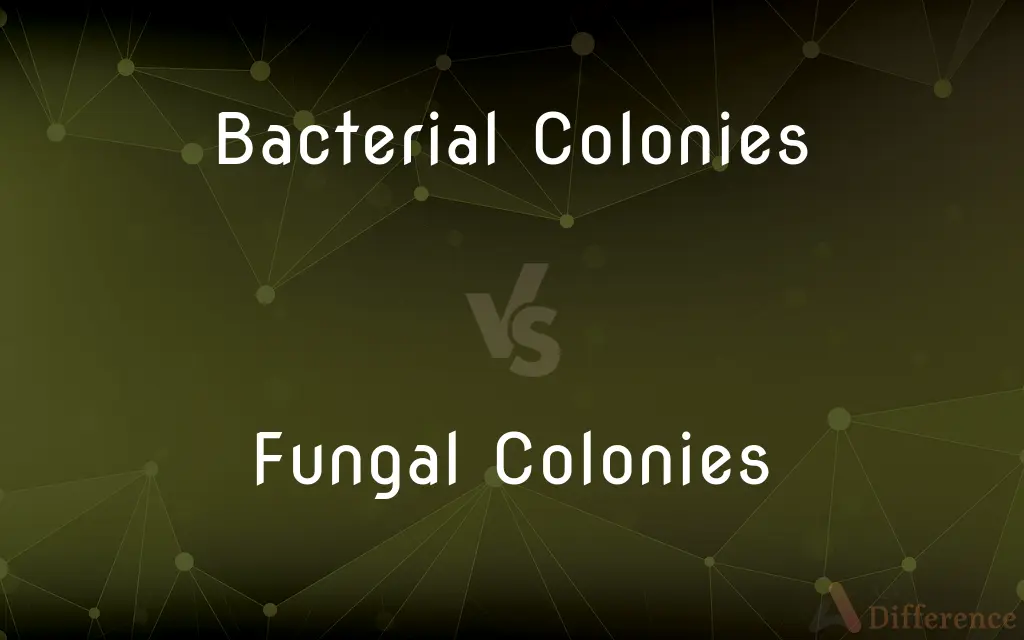Bacterial Colonies vs. Fungal Colonies — What's the Difference?
By Tayyaba Rehman — Published on January 17, 2024
Bacterial Colonies are groups of bacteria growing on a solid medium; Fungal Colonies are groups of fungi, often with visible structures, growing similarly.

Difference Between Bacterial Colonies and Fungal Colonies
Table of Contents
ADVERTISEMENT
Key Differences
Bacterial Colonies refer to visible clusters of bacteria that have arisen from a single bacterial cell and grown on a solid growth medium. Fungal Colonies, however, pertain to clusters of fungi, which can often be differentiated by their textured and multicellular structures.
When observing Bacterial Colonies, one often notes their smooth, shiny, and often circular appearance on agar plates. In contrast, Fungal Colonies may exhibit a fluffy, filamentous, or even a cottony texture, representing the mycelial growth of fungi.
The reproduction in Bacterial Colonies is typically by binary fission, leading to identical progeny. On the other hand, Fungal Colonies reproduce both sexually and asexually, resulting in spore production which can be seen in mature colonies.
Bacterial Colonies often grow more rapidly than their fungal counterparts due to the fast division rates of many bacteria. Fungal Colonies might grow slower, and over time, exhibit sporulating structures or changes in color based on their life cycle.
In terms of medical importance, both Bacterial Colonies and Fungal Colonies can be pathogenic. Bacteria can lead to a myriad of infections, while fungal pathogens can cause diseases like athlete's foot or ringworm.
ADVERTISEMENT
Comparison Chart
Basic Composition
Clusters of bacteria
Clusters of fungi
Typical Appearance
Smooth, shiny, often circular
Fluffy, filamentous, or cottony
Reproduction Method
Binary fission
Both sexually and asexually
Growth Speed
Typically faster
Generally slower
Examples of Diseases Caused
Strep throat, Tuberculosis
Athlete's foot, Ringworm
Compare with Definitions
Bacterial Colonies
Grow by binary fission, leading to identical cells.
Each cell in Bacterial Colonies divides to form two identical daughter cells.
Fungal Colonies
Can vary widely in appearance, depending on the fungal species.
Some Fungal Colonies are slimy, while others appear dry and powdery.
Bacterial Colonies
They represent visible growth indicating bacterial proliferation.
The spread of Bacterial Colonies on a plate indicates the need for better sanitation.
Fungal Colonies
Exhibit both sexual and asexual reproduction methods.
Mature Fungal Colonies can produce spores that spread to new locations.
Bacterial Colonies
Can vary in color, size, and shape based on bacterial type.
Some Bacterial Colonies produce pigments, resulting in colored growths on media.
Fungal Colonies
Often slower-growing than bacteria and can change over time.
Over weeks, some Fungal Colonies develop sporulating structures.
Bacterial Colonies
Often uniform in appearance due to arising from one progenitor.
The consistency in Bacterial Colonies' size can help in identifying the bacterial species.
Fungal Colonies
Represent multicellular assemblies, displaying hyphal growth.
Unlike bacteria, Fungal Colonies exhibit a network of filaments called mycelium.
Bacterial Colonies
Bacterial Colonies are clusters of bacteria grown from a single cell on solid media.
Scientists often count Bacterial Colonies on petri dishes to estimate the number of bacteria in a sample.
Fungal Colonies
Fungal Colonies are growths of fungi on solid media, often with distinguishable structures.
Fungal Colonies on bread appear as white or green patches with a distinct texture.
Common Curiosities
What are Bacterial Colonies?
They're visible clusters of bacteria grown on solid growth media.
How are Fungal Colonies different from bacterial ones?
Fungal Colonies exhibit textured growths with structures, while bacterial ones are smoother.
What textures can Fungal Colonies have?
They can be fluffy, filamentous, or cottony, depending on the fungus.
How do Bacterial Colonies reproduce?
Typically by binary fission, leading to identical cells.
Can you see Bacterial Colonies with the naked eye?
Yes, once they've grown large enough on media like agar plates.
Are all Fungal Colonies harmful?
No, many are harmless, and some even beneficial, like those in fermented foods.
Do Fungal Colonies have a specific smell?
Some emit distinct odors, aiding in their identification.
Why might Fungal Colonies appear in different colors?
It can be due to spore production, pigments, or the fungal life cycle stage.
How are Bacterial Colonies used in labs?
They help in estimating bacterial numbers and identifying bacterial types.
Can Fungal Colonies cause diseases?
Yes, some fungi are pathogenic and can lead to conditions like athlete's foot.
Do Bacterial Colonies always look the same?
No, they can vary in size, shape, and color based on the bacterial species.
Can both Bacterial Colonies and Fungal Colonies appear on the same medium?
Yes, if both bacterial and fungal organisms are present in the sample.
What does the appearance of Bacterial Colonies indicate?
It can provide clues about the type of bacteria and its characteristics.
Can Fungal Colonies be found in households?
Yes, they often appear on old food, damp walls, or spoiled items.
How fast do Bacterial Colonies grow?
Growth rates vary, but many bacteria divide rapidly, leading to quick colony formation.
Share Your Discovery

Previous Comparison
Pamprin vs. Ibuprofen
Next Comparison
Airpods 1 vs. Airpods 2Author Spotlight
Written by
Tayyaba RehmanTayyaba Rehman is a distinguished writer, currently serving as a primary contributor to askdifference.com. As a researcher in semantics and etymology, Tayyaba's passion for the complexity of languages and their distinctions has found a perfect home on the platform. Tayyaba delves into the intricacies of language, distinguishing between commonly confused words and phrases, thereby providing clarity for readers worldwide.














































